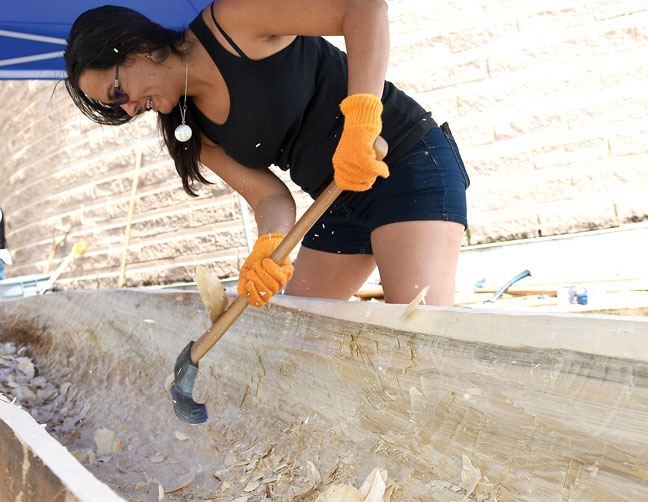Even the Titanic was put to the test in sea trials before it set out on its fateful journey.
The same cannot be said about Jennifer Pighin's dugout canoe.
She and her paddling partner, Clay Pountney, are putting their faith in a 16-foot chunk of cottonwood which has never been dipped in water. They're hoping it will deliver them 35 kilometres on the Nechako and Fraser rivers from Wilkins Park in Miworth to Lheidli T'enneh Memorial Park in Sunday's Northern Hardware canoe race.
Until about two weeks ago, the idea of taking part in the race hadn't crossed Pighin's mind. But when Tracey Calagheros of The Exploration Place hired Robert and Edie Frederick to build a dugout canoe to become part of the museum's new Path of the Paddle display, Pighin thought it should be used as canoe before it became an artifact.
"We drummed for the race last year and I thought it would be cool to bring a dugout into the race but we didn't have access to one at the time, it takes forever to make one," said Pighin. "As soon as we realized it might be done in time, I started thinking about it.
"Our goal is just to make it, and hopefully not tip, and to have fun. Probably most of the time people will be talking to us asking what the hell is that. I hear it will be really tippy but I don't know."
It took just 10 days to make the dugout. A straight tree with no knots or rot was selected and cut by Fortwood Homes to make way for a new house in College Heights and was brought to the front of the museum. It was cut in half lengthwise and then a V-shaped chunk was taken out of it using a saw. Four carvers - the Fredericks, Pighin and Ian Baird - have been the primary builders, with plenty of help from a steady stream of volunteers.
Sunday's race offers paddlers a choice of two distances. The Mackenzie route, which starts at Isle Pierre, is 67.5 km and the Simon Fraser route is 35 km. Pighin grew up on the Lhezbaonnichek Lheidli T'enneh reserve across the Nechako from Miworth and she's floated down the same stretch of river hundreds of times on various watercraft, but never in a dugout canoe.
"It's too heavy to do test runs, we're just gung-ho," said Pighin, whose only paddle race experience was a longboat event while she was going to university in Vancouver. "We launched one before in the river and there were four or five people in that one, so we know it will float. I grew up on the river and I know it fairly well. I just have to put some thought into where on the river we'll get around the fastest."
This is the fifth dugout canoe Robert Frederick has built and it was done in the least amount of time. He learned the art from his dad and the elders in his community.
"If it's going in the water Sunday and I see our crew coming in first, going full speed, I'll be happy," said Robert Frederick.
Pighin is hoping her dugout entry will inspire a new class of racing in the Northern Hardware event. She and Pountney will be using paddles and 10-foot wooden poles to make their way along the river. Traditionally, poles were the tool of choice for First Nations people in their canoes for fishing and hunting and the rivers were the only way to reach other communities.
"It'll be fun and I hope I can keep up with the paddling, it's been years since I've been in a canoe," said Pountney. "I'm a water person and I can swim well, so I'm not scared of being thrown into the water. I think if we get close to the side (of the river) but when you get in the current you can really use a paddle. It might be a little less manoeuverable, but with the extra weight (estimated at 250 pounds unloaded) there might be a speed advantage.
"It would be hard to bring it back (and flip it upright) if it tips. The trick is to not tip and to finish it. It looks like a seaworthy vessel and I think it will do well."
The race starts at 9 a.m. Sunday from Isle Pierre. The paddlers at Miworth will start at 10:30 a.m., and the faster boats are expected to arrive in Prince George between 12:30 and 1 p.m.



